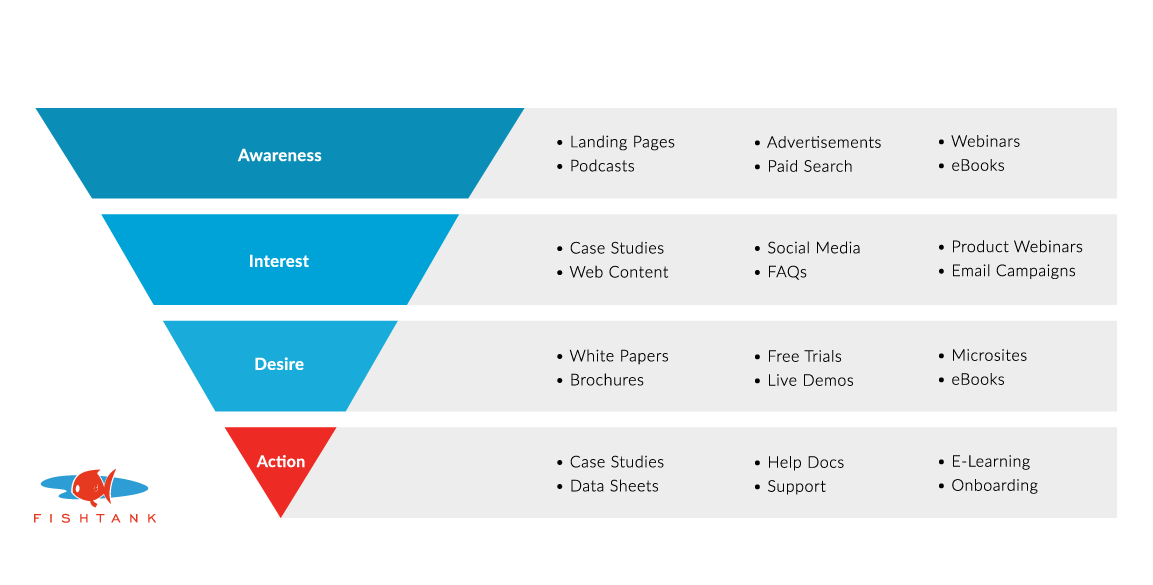Content marketing is a form of marketing focused on creating, publishing and distributing content for a targeted audience online.
Content creation is the basis of every marketing strategy. Given the multitude of platforms and infinite ways to share content online, formulating a content strategy can feel overwhelming. One way to streamline your marketing is through content marketing. This blog will go over what content marketing entails, why you should bother with it, and some helpful tactics to implement at different stages of your customer journey.
Benefits Of Implementing A Content Marketing Strategy
Increased Conversion Rate
Content can make or break a sale. Not only will valuable content generate more leads for your business, but it can also increase your conversion rate.
Target Users At Every Stage Of The Buying Cycle
Communicate your brand's value to users at each stage of their buying journey. Tailor your content to target leads that funnels them through every stage.
Improved Customer Satisfaction & Retention
Your relationship with your customers doesn't end when you make a sale. Continue to nurture and up-sell your customers with a customer communication plan focused on loyalty and retention.
Increased Website Ranking On Google (SEO)
70% of purchase journeys start on Google. Acquiring more site traffic with quality content that optimizes your website's position on Google search. Search engine optimization is a long-term strategy that requires consistent, quality content. Remember, if you aren't producing the best content for your customers, someone else will.
Creating Content For Every Stage Of The Customer Journey
By creating content for every stage of the entire customer journey life cycle, you can ensure the information you deliver to your prospective customers is specific to their needs.
So, what content should you create? Take the time to determine who you are creating for, where in the customer journey your potential leads are, and how you want to deliver the content.
Let's look at the different stages of the customer journey, or in other words, the sale and marketing funnel. Here are several different content types you can integrate into your marketing mix.

Top-Of-The-Funnel Content
The first stage of the marketing funnel is awareness, or in other words, top-of-the-funnel (TOFU). Because the top of the funnel is the widest, this means the audience is the most general and the least ready to convert. Potential customers in the TOFU phase are typically experiencing a problem and are researching a way to fix it. Users and visitors in the awareness phase are usually encountering your content and brand for the first time. TOFU content should be informative and authoritative, therefore considering creating content such as:
- Landing Pages
- Podcasts
- Advertisements
- Paid Search
- Webinars
- eBooks
Middle-Of-The-Funnel Content
The next stage of the marketing funnel is Interest and Desire, or in other words, middle-of-the-funnel (TOFU). Once users are made aware of your business and brand, they will conduct intensive research on your brand and the services you offer. The Interest and Desire phases in the marketing funnel offer content that communicates your brand's experience as an authority in your industry. Consider your target audiences and buyer personas closely as they may be warmer leads. The content you write catering to clients in this phase will help them make better purchasing decisions and convert such as:
- Case Studies
- Web Content
- Social Media
- FAQs
- Product Webinars
- Email Campaigns
- White Papers
- Brochures
- Free Trials
- Live Demos
- Microsites
- eBooks
Bottom-Of-The-Funnel Content
The Bottom-Of-The-Funnel (BOFU) content should be sales copy directed at customers with high shopping intent. Customers at this stage in the funnel should offer customers CTA, promotions, limited-time offers, and discounts. Here are some options for delivering the content to get the sale:
- Case Studies
- Data Sheets
- Helps Docs
- Support
- E-Learning
- Onboarding
Use these suggestions to help guide the nature of your content. One important consideration about your content marketing strategy is that organic search works across the entire customer journey.
Most of the content you create might be for the top of the funnel to increase brand awareness and communicate the value of your brand. The top of the funnel is where the majority of your marketing leads will start, and although fewer leads continue on the customer journey, the more qualified they become.
Optimize Your Content Marketing Strategy For SEO
Once you've decided on the content, you plan to create. Don't forget all of the content you publish has the potential to optimize for SEO at every stage of the customer journey. Focus on ensuring your content marketing program will have a plan to drive significant SEO value. Part of the planning process includes conducting keyword research and backlink analysis. This allows you to identify critical terms as a basis on which to create content. Backlink analysis can collect data on similar content that has gotten good organic traffic from the market.
Need Help Implementing A Content Marketing Strategy?
Whether you need copywriting, content authoring, or a custom content strategy, the capable team at Fishtank Consulting has your back. We offer custom content strategies based on SEO keyword research, persona building, and journey mapping. This approach ensures you're getting the right content, to the right person, at the right time. We can help with everything from web pages, blogs, social media, ads to eBooks. We can create content designed to convert at every stage of the buying cycle.




